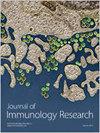艾滋病毒和丙型肝炎病毒双重感染期间肝星状细胞的旁观者效应和损伤相互作用
IF 3.6
3区 医学
Q2 IMMUNOLOGY
引用次数: 0
摘要
本研究旨在探讨 HCV 和 HIV 共同感染对肝纤维化的影响。研究人员建立了一个可同时活跃复制两种病毒的共培养系统,其中包含 CD4 T 淋巴细胞(Jurkat)、肝星状细胞(LX-2)和肝细胞(Huh7.5)。LX-2 细胞对 HIV 感染的易感性是通过测量 HIV 受体表达、暴露于无细胞病毒以及与感染 HIV 的 Jurkat 细胞进行细胞间接触来评估的。研究评估了凋亡参数,包括程序性细胞死亡、ROS 失衡、细胞因子(IL-6、TGF-β 和 TNF-α)以及细胞外基质成分(胶原蛋白、α-SMA 和 MMP-9)。利用从感染 HCV 的肝细胞中释放的可溶性因子研究了 HCV 感染对 LX-2/HIV-Jurkat 的影响。尽管LX-2细胞不会直接感染HIV,但观察到了旁观者效应,导致氧化应激增加和凋亡细胞因子释放失调。与感染艾滋病毒的 Jurkat 细胞共培养会加剧肝纤维化、氧化还原失衡、凋亡细胞因子的表达和细胞外基质的生成。与此相反,HCV 感染的 Huh7.5 细胞表现出凋亡基因转录的升高,但对 LX-2/HIV-Jurkat 协同培养没有明显影响。这项研究强调了在 HCV/HIV 合并感染期间,HIV 感染的淋巴细胞是如何加剧肝纤维化的。它们通过直接接触和可溶性因子增加了肝星状细胞的氧化应激、促坏细胞因子水平和细胞外基质的产生。这些见解为双重感染者提供了宝贵的潜在疗法。本文章由计算机程序翻译,如有差异,请以英文原文为准。
Bystander Effects and Profibrotic Interactions in Hepatic Stellate Cells during HIV and HCV Coinfection
This study aims to explore the influence of coinfection with HCV and HIV on hepatic fibrosis. A coculture system was set up to actively replicate both viruses, incorporating CD4 T lymphocytes (Jurkat), hepatic stellate cells (LX-2), and hepatocytes (Huh7.5). LX-2 cells’ susceptibility to HIV infection was assessed through measurements of HIV receptor expression, exposure to cell-free virus, and cell-to-cell contact with HIV-infected Jurkat cells. The study evaluated profibrotic parameters, including programed cell death, ROS imbalance, cytokines (IL-6, TGF-β, and TNF-α), and extracellular matrix components (collagen, α-SMA, and MMP-9). The impact of HCV infection on LX-2/HIV-Jurkat was examined using soluble factors released from HCV-infected hepatocytes. Despite LX-2 cells being nonsusceptible to direct HIV infection, bystander effects were observed, leading to increased oxidative stress and dysregulated profibrotic cytokine release. Coculture with HIV-infected Jurkat cells intensified hepatic fibrosis, redox imbalance, expression of profibrotic cytokines, and extracellular matrix production. Conversely, HCV-infected Huh7.5 cells exhibited elevated profibrotic gene transcriptions but without measurable effects on the LX-2/HIV-Jurkat coculture. This study highlights how HIV-infected lymphocytes worsen hepatic fibrosis during HCV/HIV coinfection. They increase oxidative stress, profibrotic cytokine levels, and extracellular matrix production in hepatic stellate cells through direct contact and soluble factors. These insights offer valuable potential therapies for coinfected individuals.
求助全文
通过发布文献求助,成功后即可免费获取论文全文。
去求助
来源期刊

Journal of Immunology Research
IMMUNOLOGY-
CiteScore
6.90
自引率
2.40%
发文量
423
审稿时长
15 weeks
期刊介绍:
Journal of Immunology Research is a peer-reviewed, Open Access journal that provides a platform for scientists and clinicians working in different areas of immunology and therapy. The journal publishes research articles, review articles, as well as clinical studies related to classical immunology, molecular immunology, clinical immunology, cancer immunology, transplantation immunology, immune pathology, immunodeficiency, autoimmune diseases, immune disorders, and immunotherapy.
 求助内容:
求助内容: 应助结果提醒方式:
应助结果提醒方式:


